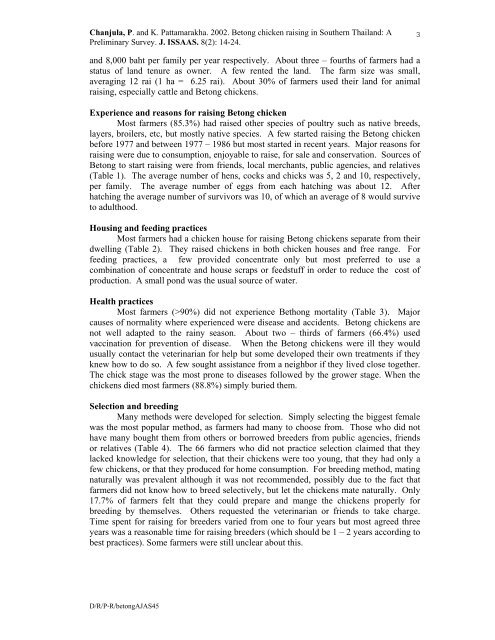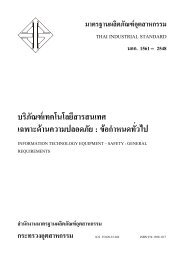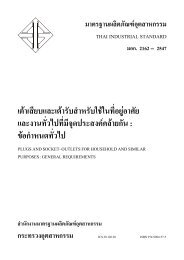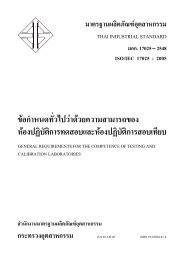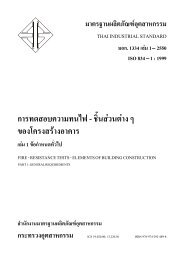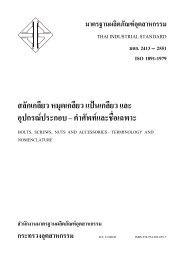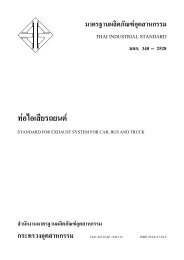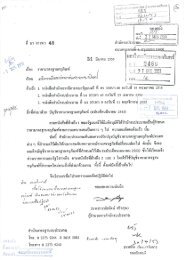Betong Chicken Raising in Southern Thailand A Preliminary
Betong Chicken Raising in Southern Thailand A Preliminary
Betong Chicken Raising in Southern Thailand A Preliminary
You also want an ePaper? Increase the reach of your titles
YUMPU automatically turns print PDFs into web optimized ePapers that Google loves.
Chanjula, P. and K. Pattamarakha. 2002. <strong>Betong</strong> chicken rais<strong>in</strong>g <strong>in</strong> <strong>Southern</strong> <strong>Thailand</strong>: A<br />
Prelim<strong>in</strong>ary Survey. J. ISSAAS. 8(2): 14-24.<br />
and 8,000 baht per family per year respectively. About three – fourths of farmers had a<br />
status of land tenure as owner. A few rented the land. The farm size was small,<br />
averag<strong>in</strong>g 12 rai (1 ha = 6.25 rai). About 30% of farmers used their land for animal<br />
rais<strong>in</strong>g, especially cattle and <strong>Betong</strong> chickens.<br />
Experience and reasons for rais<strong>in</strong>g <strong>Betong</strong> chicken<br />
Most farmers (85.3%) had raised other species of poultry such as native breeds,<br />
layers, broilers, etc, but mostly native species. A few started rais<strong>in</strong>g the <strong>Betong</strong> chicken<br />
before 1977 and between 1977 – 1986 but most started <strong>in</strong> recent years. Major reasons for<br />
rais<strong>in</strong>g were due to consumption, enjoyable to raise, for sale and conservation. Sources of<br />
<strong>Betong</strong> to start rais<strong>in</strong>g were from friends, local merchants, public agencies, and relatives<br />
(Table 1). The average number of hens, cocks and chicks was 5, 2 and 10, respectively,<br />
per family. The average number of eggs from each hatch<strong>in</strong>g was about 12. After<br />
hatch<strong>in</strong>g the average number of survivors was 10, of which an average of 8 would survive<br />
to adulthood.<br />
Hous<strong>in</strong>g and feed<strong>in</strong>g practices<br />
Most farmers had a chicken house for rais<strong>in</strong>g <strong>Betong</strong> chickens separate from their<br />
dwell<strong>in</strong>g (Table 2). They raised chickens <strong>in</strong> both chicken houses and free range. For<br />
feed<strong>in</strong>g practices, a few provided concentrate only but most preferred to use a<br />
comb<strong>in</strong>ation of concentrate and house scraps or feedstuff <strong>in</strong> order to reduce the cost of<br />
production. A small pond was the usual source of water.<br />
Health practices<br />
Most farmers (>90%) did not experience Bethong mortality (Table 3). Major<br />
causes of normality where experienced were disease and accidents. <strong>Betong</strong> chickens are<br />
not well adapted to the ra<strong>in</strong>y season. About two – thirds of farmers (66.4%) used<br />
vacc<strong>in</strong>ation for prevention of disease. When the <strong>Betong</strong> chickens were ill they would<br />
usually contact the veter<strong>in</strong>arian for help but some developed their own treatments if they<br />
knew how to do so. A few sought assistance from a neighbor if they lived close together.<br />
The chick stage was the most prone to diseases followed by the grower stage. When the<br />
chickens died most farmers (88.8%) simply buried them.<br />
Selection and breed<strong>in</strong>g<br />
Many methods were developed for selection. Simply select<strong>in</strong>g the biggest female<br />
was the most popular method, as farmers had many to choose from. Those who did not<br />
have many bought them from others or borrowed breeders from public agencies, friends<br />
or relatives (Table 4). The 66 farmers who did not practice selection claimed that they<br />
lacked knowledge for selection, that their chickens were too young, that they had only a<br />
few chickens, or that they produced for home consumption. For breed<strong>in</strong>g method, mat<strong>in</strong>g<br />
naturally was prevalent although it was not recommended, possibly due to the fact that<br />
farmers did not know how to breed selectively, but let the chickens mate naturally. Only<br />
17.7% of farmers felt that they could prepare and mange the chickens properly for<br />
breed<strong>in</strong>g by themselves. Others requested the veter<strong>in</strong>arian or friends to take charge.<br />
Time spent for rais<strong>in</strong>g for breeders varied from one to four years but most agreed three<br />
years was a reasonable time for rais<strong>in</strong>g breeders (which should be 1 – 2 years accord<strong>in</strong>g to<br />
best practices). Some farmers were still unclear about this.<br />
D/R/P-R/betongAJAS45<br />
3


